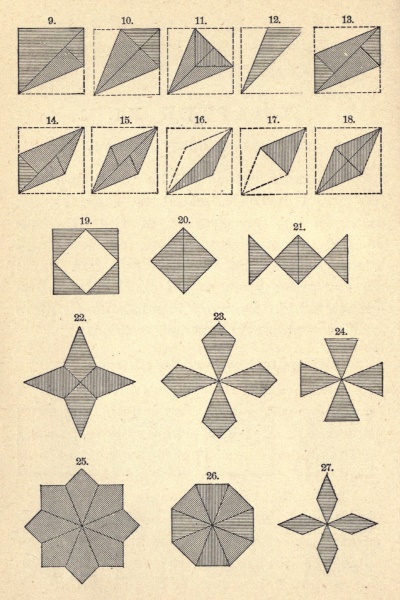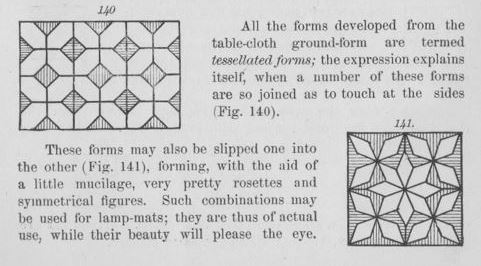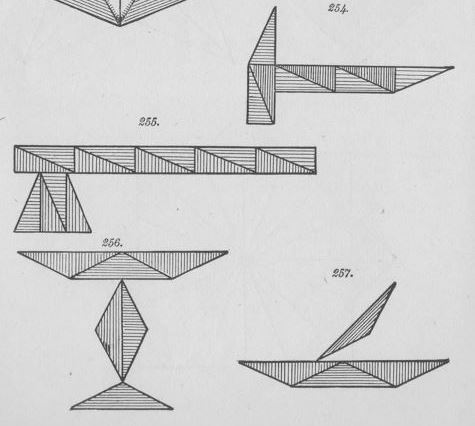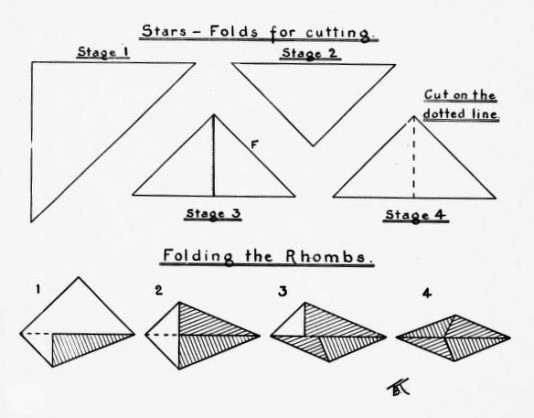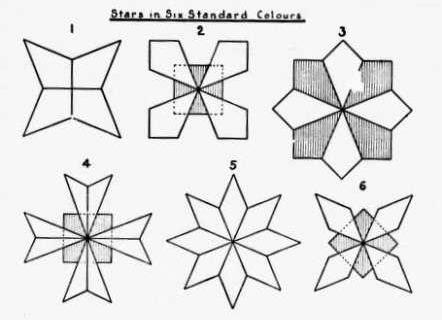| The Public Paperfolding History Project
Last updated 13/11/2025 x |
|||||||
| The Froebelian Occupation of Falten - Combinations | |||||||
This page is being used to collect information about the combining of folded shapes into larger patterns which formed part of the Froebelian Occupation of Falten. Please contact me if you know any of this information is incorrect or if you have any other information that should be added. Thank you. There appear to be two types of Combinations, of Schonnheitsformen and of Erkenntnisformen. Koehler (see entry for 1862) refers to the laying together of Erkenntnisformen as 'Legetafelchen' (laying boards), whereas Heerwart (see entry for 1895) says that Froebel called the laying together of Schonnheitsformen 'Gefatel formen' ((patterns of inlaid wood). At present this page is being used to collect information about both types, although they may be separated at some future point. ********** 1862 'Das Frobel'sche Faltblatt' (Frobel's Folding Sheet) ) by August Koehler, which was published by Hermann Bohlau in Weimar in 1862, contains a paragraph which says, roughly, ''As the following examples show, the shapes can also be arranged one below the other. By using the above course of study, the child receives the same material that Froebel presented under the name 'Legetafelchen' (laying boards)'.
********** 1875 As far as I know, this Additional Occupation first appears in 'Die Formenarbeiten: Part 3: Das Falten' by Alois Fellner, which was published by Verlag von A. Pichler's Witwe & Sohn in Vienna in 1875.
********** The same occupation also appears: 1877 In 'Primary Methods: A Complete and Methodical Presentation of the Use of Kindergarten Material in the Primary School' by W N Hailmann, which was published by A S Barnes and Company in New York and Chicago in 1887, where the results are called 'social syntheses' ie patterns made by combining shapes folded by several children.
********** 1882 'The Kindergarten Guide' by Maria Kraus Boelte and John Kraus, which was published by E. Steiger and Company in New York and by George Philip and Son in London, probably in 1882, shows how to combine Schonnheitsformen ()both uncut and cut designs) into larger patterns and Erkenntnisformen into both geometric patterns and Folds of Life.
********** 1895 'Course of Paperfolding' by Eleonore Heerwart, which was published by Charles and Dible in London and Glasgow in 1895, mentions 'Gefatel formen' twice in connection with the combination of Schonnheitsformen into larger patterns.:
(Note: It seems likely to me that there is a misprint here and that the first sentence should end after (forms of beauty).) **********
********** The same work also contains a section about creating stars and polygons by combining folded shapes. The examples include a seven-point star 'accidentally discovered by Miss S M Crombie'.
Note that figure 5 on Plate XXIX is a heptagonal star.
********** 1910 'Educational Handwork' by T B Kidner, which was published by The Educational Book Company Limited in Toronto in 1910, contains a section explaining how to fold or fold and cut) simple mosaic pieces suitable for arranging into stars.
********** |
|||||||


